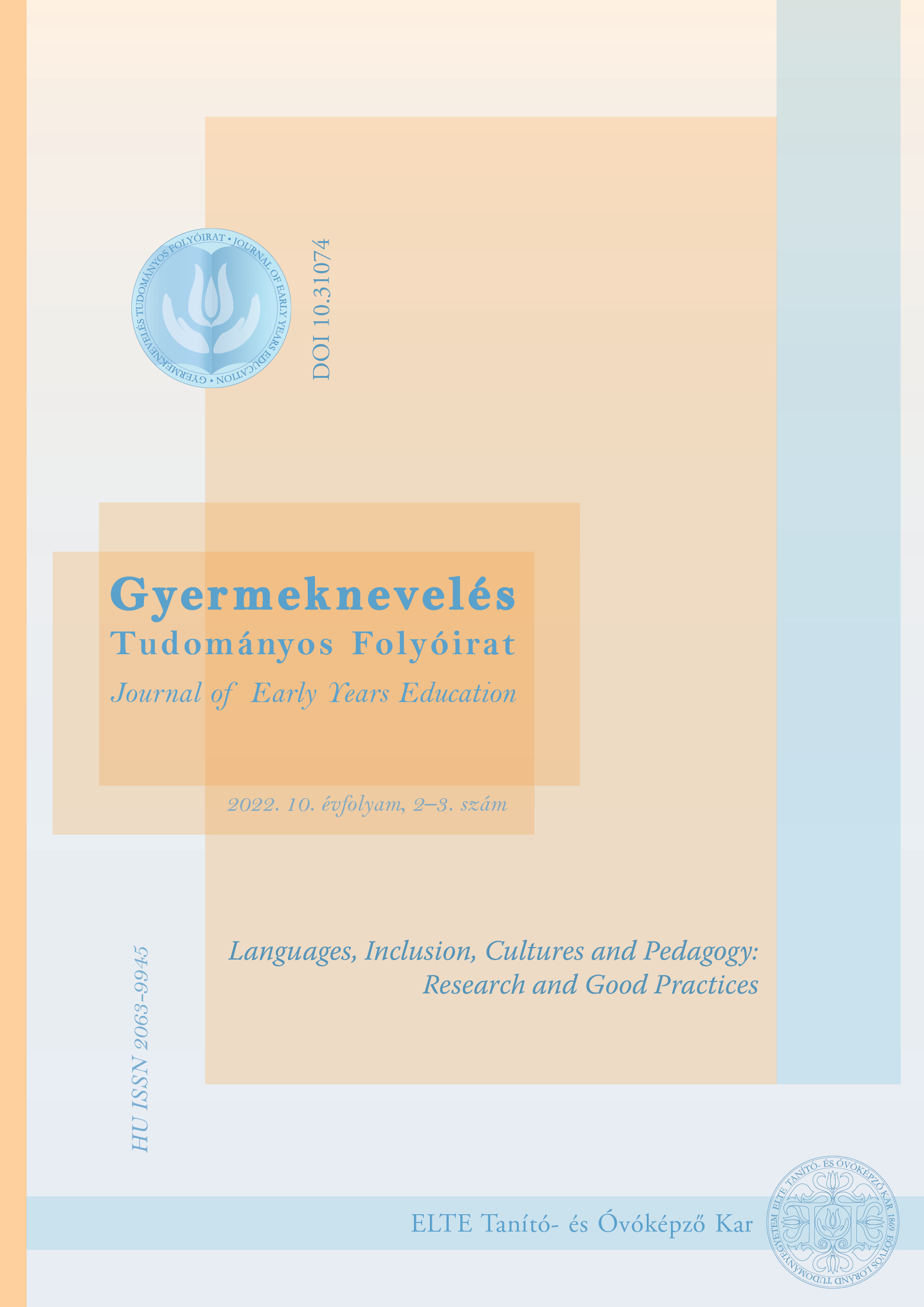Has what was ‘Too far for you to see’ come any closer? Language and Identity in Wales
DOI:
https://doi.org/10.31074/gyntf.2022.2.323.336Kulcsszavak:
bilingualism, Wales, identity consciousness, language acquisition, diachronic language analysisAbsztrakt
This article examines issues of language usage in Welsh and the identity of this region’s residents. The stress is upon people and language as they are inseparably inter- and entwined when forming one’s identity (Evans, 2018, p. 7). In accordance with this approach, I focus on three aspects (of this people, language, and identity): 1) the “diachronic” analysis of the Welsh language; 2) bilingual language use in general and in Wales in particular; 3) the recent period and research that slowly led to Welsh becoming an official language, effective in 2012. In this paper I will discuss what has happened since the poet, R. S. Thomas, captured the feelings and thoughts of his era while expressing his worries for his nation’s fate in the poem, The Welsh Hill County. I believe that my inquiry suits the environment of languages and cultures as the success story of an almost extinct language that survived its foretold death may provide valuable insight into the actual problems minority groups fighting for their rights face. What is more, I find this question important from the viewpoint of a second language teacher: the way we acquire languages in a naturally (albeit sometimes hostile) bilingual region can furnish further ways to enhance language learning abilities of students. The role played by the Welsh in Wales and the UK serves as a good example of the above interests.
Letöltések
Hivatkozások
Aitchison, J. W., Carter, H & Williams, C. H. (1985). The Welsh Language at the 1981 Census, Area, 17, 11–17. https://www.jstor.org/stable/20002113
Baker, C. (1985). Aspects of Bilingualism in Wales. Multilingual Matters Ltd.
Bartha, C. (1999). A kétnyelvűség alapkérdései. Nemzeti Tankönyvkiadó.
Evans, D. (2018). Identity and language. Bloomsbury Publishing Plc.
Gervain, J. (2011). A csecsemőkori beszédészlelés mechanizmusai és a nyelvelsajátítás, Magyar Tudomány, 172(8), 913–919. http://www.matud.iif.hu/2011/08/04.htm.
Kontra, M. & Hattyár, H. (2002, Eds.). Magyarok és nyelvtörvények. Teleki László Alapítvány https://www.mek.oszk.hu/12100/12123/12123.pdf
Márkus, É. & Trentinné Benkő, É. (2014, Eds). A korai idegen nyelvi fejlesztés elmélete és gyakorlata: Konferenciaelőadások és háttértanulmányok, ELTE Eötvös Kiadó.
Márkus, É., M. Pintér, T., Trentinné Benkő, É. (2017, Eds.). Jó gyakorlatok a korai idegennyelvi fejlesztésben Oktatás, fejlesztés, kutatás. Eötvös Loránd Tudományegyetem Tanító- és Óvóképző Kar.
McDowall, D. (1992). An Illustrated History of Britain. Longman, Harlow.
Navracsics, J. (2000). A kétnyelvű gyermek. Corvina.
Vihman, M., Thierry, G., Lum, J., Keren-Portnoy, T. & Martin, P. (2007). Onset Of Word Form Recognition In English, Welsh, And English–Welsh Bilingual Infants. Applied Psycholinguistics, 28(3), 475-493. https://doi.org/10.1017/S0142716407070269
Williams, E. (2009). ‘Language attitudes and identity in a North Wales town: “Something different about Caernarfon”?, International Journal of the Sociology of Language, 195, 63–91. https://doi.org/10.1515/IJSL.2009.006
Websites
An Assembly for Wales/Senedd i Gymru, Executive Summary, https://www.ucl.ac.uk/constitution-unit/sites/constitution-unit/files/4.pdf,
Apple Jr. R. W. (1979). The Welsh Rejected Limited Autonomy, the Scots Split on the Issue, The New York Times, https://www.nytimes.com/1979/03/04/archives/callaghans-devolution-strategy-didnt-work.html
BBC (2014). Cymru Wales, Hwyel Dda: https://www.bbc.co.uk/wales/history/sites/themes/society/royalty_hwyel_dda.shtml
Blick, A. (2014). Devolution in the UK: Historical Perspective, https://www.local.gov.uk/sites/default/files/documents/devolution-uk-historical--827.pdf
Defining Schools according to Welsh Medium Provision, https://gov.wales/sites/default/files/publications/2018-02/defining-schools-according-to-welsh-medium-provision.pdf
Eryri Snowdonia, (2021). Welsh Language, https://www.visitsnowdonia.info/welsh-language.
Encyclopedica Britannica (2021). Government and Society. https://www.britannica.com/topic/Welsh-Language-Society Europeans and their Languages (2012). Special Eurobarometer, https://ec.europa.eu/commfrontoffice/publicopinion/archives/ebs/ebs_386_en.pdf.
Hyvel Dda, Canolphan Centre, (2010). “The only Garden in Europe dedicated to the Law”, https://www.hywel-dda.co.uk/
National Assembly for Wales, (2013). Official Language Scheme, Official Languages Scheme, July 2013
Lewis, S. (1962). Tynged yr Iaith/ Fate of the Language, https://www.youtube.com/watch?v=j7ntVx4m3YU
Lewis, S. (1962). Fate of the Language (transcript), https://morris.cymru/testun/saunders-lewis-fate-of-the-language.html,
Llywodraeth Cymru-Welsh Government (2020). Welsh Language-Fast Facts, https://learnwelsh.cymru/about-us/welsh-language-fast-facts/
Office for National Statistics (2011). Proficiency in English, http://www.nomisweb.co.uk/census/2011/QS205EW/view/2092957700?cols=measures
Office for National Statistics (2011). Welsh Language Skills, http://www.nomisweb.co.uk/census/2011/QS206WA/view/2092957700?cols=measures
Senedd Cymru, Welsh Parliament (2021). Legislation, https://senedd.wales/senedd-business/legislation/
Senedd Cymru, Welsh Parliament (2021). History of devolution, https://senedd.wales/how-we-work/history-of-devolution/
Senedd Cymru, Welsh Government (2015). Positive Planning Implementation Plan 2015, https://gov.wales/sites/default/files/publications/2019-05/positive_planning_implementation_plan.pdf
Senedd Cymru, Welsh in Education, Action plan 2017-21, https://gov.wales/sites/default/files/publications/2018-02/welsh-in-education-action-plan-2017%E2%80%9321.pdf
Senedd Cymru, Welsh Governemnt, Cymraeg 2050, A million Welsh speakers. https://gov.wales/sites/default/files/publications/2018-12/cymraeg-2050-welsh-language-strategy.pdf
Szoó, A. (2020). „Brussels should pay attention to the Szeklers” – Day of Szekler Autonomy), https://transylvanianow.com/brussels-should-pay-attention-to-the-szeklers-day-of-szekler-autonomy/
Thomas, R. S. The Welsh Hill County: https://www.youtube.com/watch?v=11da18FiolQ
The National Library of Wales, Welsh Bible 1588, https://www.library.wales/discover/digital-gallery/printed-material/1588-welsh-bible#?c=&m=&s=&cv=&xywh=-882%2C-1%2C4726%2C4026
Thiec, A. (1997). Devolution to Scotland and Wales: From the Failure of 1979 to the Success of 1997, https://crini.univ-nantes.fr/medias/fichier/thiec_1207554092397.pdf?ID_FICHE=421226&INLINE=FALSE
Trentinné Benkő, É. (2014). A kétnyelvű fejlesztés és a pedagógusképzés, http://nevelestudomany.elte.hu/downloads/2014/nevelestudomany_2014_3.pdf
Trentinné Benkő, Éva (2016). Ten Years of CLIL Teacher Training at ELTE TÓK, http://www.irisro.org/edusoc2016nov/33TrentinneBenkoEva.pdf.
University of Portsmouth, A Vision of Britain through Time, https://www.visionofbritain.org.uk/census/EW1921GEN/11
Welsh in Education, Action Plan 2017-21, https://gov.wales/sites/default/files/publications/2018-02/welsh-in-education-action-plan-2017%E2%80%9321.pdf
##submission.additionalFiles##
Megjelent
Hogyan kell idézni
Folyóiratszám
Rovat
License
Copyright (c) 2022 Szerző

This work is licensed under a Creative Commons Attribution-NonCommercial-ShareAlike 4.0 International License.

